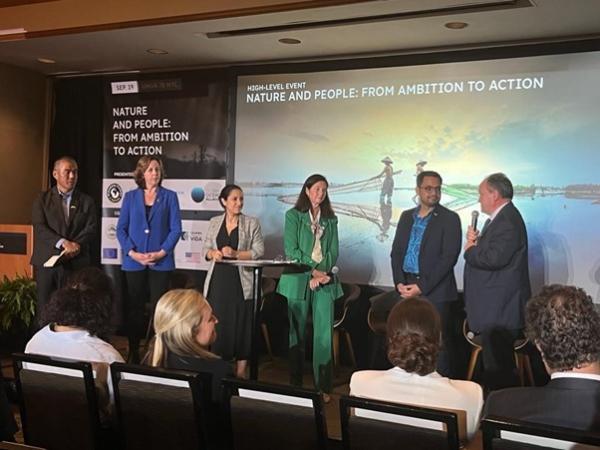
- Threats from climate change to biodiversity and ecosystems identified as key risk
- Assessing biodiversity risk will help guide future investments and frame support for biodiversity
- Collective work of Multilateral Development Banks (MDBs) will frame EIB’s approach to finance that protects and supports nature
Supporting investments protecting biodiversity and managing the risks from the threat posed to nature and biodiversity in EIB projects and are key elements of the EIB’s nature-positive framework presented by EIB Vice President Ambroise Fayolle on the margins of the United Nations General Assembly today.
Speaking at an event convened on the margins of the United Nations General Assembly in New York by the High Ambition Coalition for Nature and People, the Global Ocean Alliance and the Leaders’ Pledge for Nature, EIB Vice President Fayolle said: “One million of the earth’s 8 million plants and animals are now threatened with extinction. This is an emergency that the EIB has committed to address in its investments and its partnerships. Building on our already operational climate risk screening system, we are developing a system to screen biodiversity risk. This will allow for the assessment of the financial risk posed by biodiversity loss and ecosystem degradation in the EIB’s portfolio and at counterparty level. “
He added, “Managing and understanding the risks is essential to guide investments both into supporting biodiversity itself and into future-proofing investments. “
More than 50% of the world’s GDP is dependent on nature and therefore exposed to risks relating to nature loss and degradation. Nature is declining at rates unprecedented in human history — and the rate of species extinctions is accelerating according to a report from the Intergovernmental Science-Policy Platform on Biodiversity and Ecosystem Services (IPBES).
The EIB is developing a methodology that will allow the Bank to assess the exposure of its clients and promoters to nature-related impacts and risks and dependencies at the asset, company and portfolio levels. This approach will be based on a definition of what is nature-positive that can easily be applied to operations and will build an understanding of the financial risk posed by biodiversity loss and ecosystem degradation to help direct financial flows away from business-as-usual models where necessary. The new biodiversity risk screening system will be finalised in 2024 with its application to EIB counterparts to start in 2025.
In 2021, MDBs adopted the “Joint MDB Statement on Nature, People and Planet”, in which they collectively committed to step up efforts towards the protection, restoration and sustainable use of nature. Today’s announcement shows how the EIB is already translating ambition into action within its nature-positive framework.
The European Investment Bank is committed to:
- Align its operations to support the goals of the post-2020 Global Biodiversity Framework
- Scale up its nature-positive investments through: mainstreaming biodiversity across policies, investments and operations; assessing nature-related impacts, dependencies and risks; and scaling climate finance with nature co-benefits
- Announce concrete initiatives, programmes, partnerships with commitments to supporting biodiversity investments and/or biodiversity co-benefits
Find out more:
Microsoft Word - MDB Joint Statement on Nature_28.10.21.docx (eib.org)
EIB Environmental and Social Standards